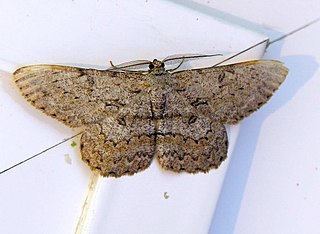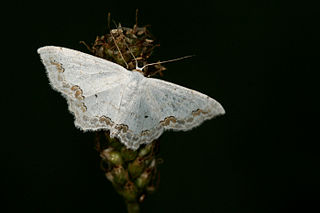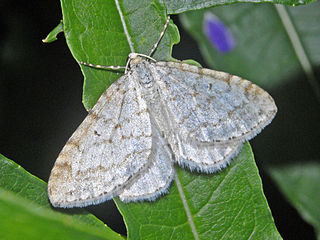
The latticed heath is a moth of the family Geometridae, belonging to the subfamily Ennominae, placed in the tribe Macariini. The genus was erected by Carl Linnaeus in his 1758 10th edition of Systema Naturae.

The common white wave is a moth of the family Geometridae. The species was first described by Carl Linnaeus in his 1758 10th edition of Systema Naturae. It is found throughout the Palearctic region .The habitat is deciduous forests and their surroundings.

Abraxas sylvata, the clouded magpie, is a Palearctic moth of the family Geometridae that was named by Giovanni Antonio Scopoli in 1763.

Ascotis selenaria, the giant looper, is a moth of the family Geometridae. The species was first described by Michael Denis and Ignaz Schiffermüller in 1775.

Hypomecis punctinalis, the pale oak beauty, is a moth of the family Geometridae. The species was first described by Giovanni Antonio Scopoli in his 1763 Entomologia Carniolica. The species can be found in central and southern Europe, Asia Minor, Transcaucasia, Russia, the Russian Far East, Japan, Korea, Ussuri and western China.

Macaria brunneata, the Rannoch looper, is a moth of the family Geometridae. The species was first described by Carl Peter Thunberg in 1784. It is found in Siberia, Japan, and northern and mountainous parts of North America, and throughout Europe, though in Britain it is largely or entirely restricted to mature forests in central Scotland.

Siona lineata, the black-veined moth, is a moth of the family Geometridae. The species was first described by Giovanni Antonio Scopoli in his 1763 Entomologia Carniolica.

Petrophora chlorosata, the brown silver-line, is a moth of the family Geometridae. The species was first described by Giovanni Antonio Scopoli in his 1763 Entomologia Carniolica. It is found in the Palearctic extending from Ireland and Britain to Asia Minor, northern Iran, the Altai mountains, Amdo, south eastern Siberia, and Japan.

Catocala fulminea, the yellow bands underwing, is a moth of the family Erebidae. The species was first described by Giovanni Antonio Scopoli in his 1763 Entomologia Carniolica. It is found in central and southern Europe, east Asia and Siberia. The xarippe lineage has been proposed to be a distinct and valid species in its own right, instead of being only subspecifically distinct.

Caradrina clavipalpis, the pale mottled willow, is a moth of the family Noctuidae. The species was first described by Giovanni Antonio Scopoli in his 1763 Entomologia Carniolica. It is found in the Palearctic realm. It is an introduced species in North America, where it was first reported from Queens in New York City in 1993. In 2009 it was found in Rochester, New York, so it appears to be established and spreading.

Agrotera nemoralis, the beautiful pearl, is a species of moth of the family Crambidae. It was first described by Giovanni Antonio Scopoli in his 1763 Entomologia Carniolica.

Stenoptilia bipunctidactyla, also known as the twin-spot plume is a moth of the Pterophoroidea family found in North Africa, Asia and Europe. It was first described by the Austrian physician and naturalist, Giovanni Antonio Scopoli in 1763. It is one of four similar looking moths.

Euchoeca is a monotypic moth genus in the family Geometridae erected by Jacob Hübner in 1823. Its only species, Euchoeca nebulata, the dingy shell, was described by Giovanni Antonio Scopoli in 1763. It is found in the Palearctic realm, from Europe across Russia to Japan.

Minoa is a genus of moths in the family Geometridae. The genus was described by Treitschke in 1825.

Sterrhinae is a large subfamily of geometer moths with some 3,000 described species, with more than half belonging to the taxonomically difficult, very diverse genera, Idaea and Scopula. This subfamily was described by Edward Meyrick in 1892. They are the most diverse in the tropics with the number of species decreasing with increasing latitude and elevation.

Chrysocrambus craterellus is a species of moth of the family Crambidae. It was first described by Giovanni Antonio Scopoli in his 1763 Entomologia Carniolica.

Scopula ornata, the lace border, is a moth of the family Geometridae. The species was first described by Giovanni Antonio Scopoli in his 1763 Entomologia Carniolica. It is found in Europe, North Africa and the Near East.

Asthenini is a tribe of geometer moths under subfamily Larentiinae first described by Warren in 1893. The tribe has been combined with Eupitheciini in the past, most notably by Jeremy Daniel Holloway in his work The Moths of Borneo.

Entomologia Carniolica exhibens insecta Carnioliae indigena et distributa in ordines, genera, species, varietates is a taxonomic work by Giovanni Antonio Scopoli, published in Vienna in 1763. As well as describing hundreds of new species, Entomologia Carniolica contained observations on the species' biology, including the first published account of queen bees mating outside the hive.

Mesotype verberata is a moth in the family Geometridae first described by Giovanni Antonio Scopoli in his 1763 Entomologia Carniolica.




















